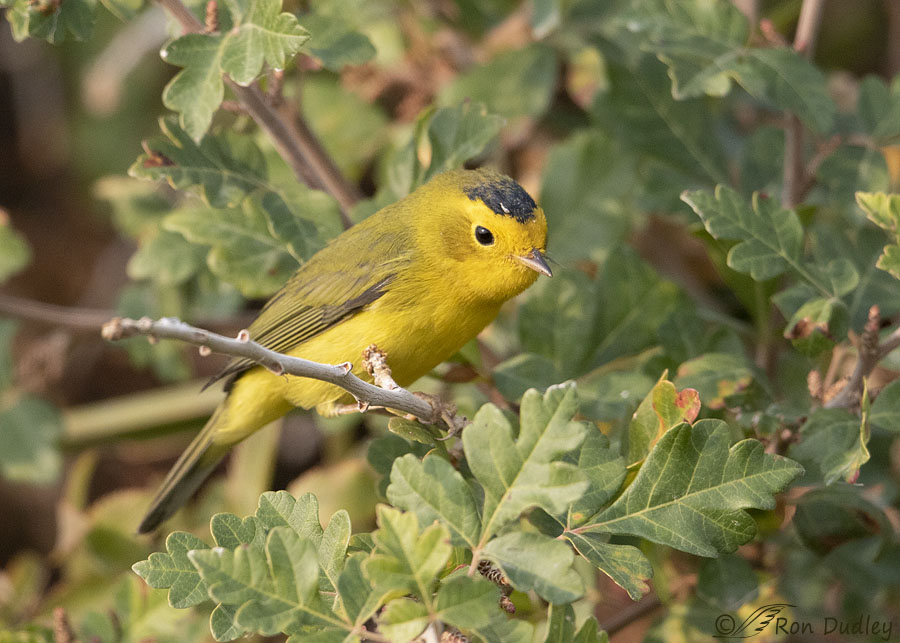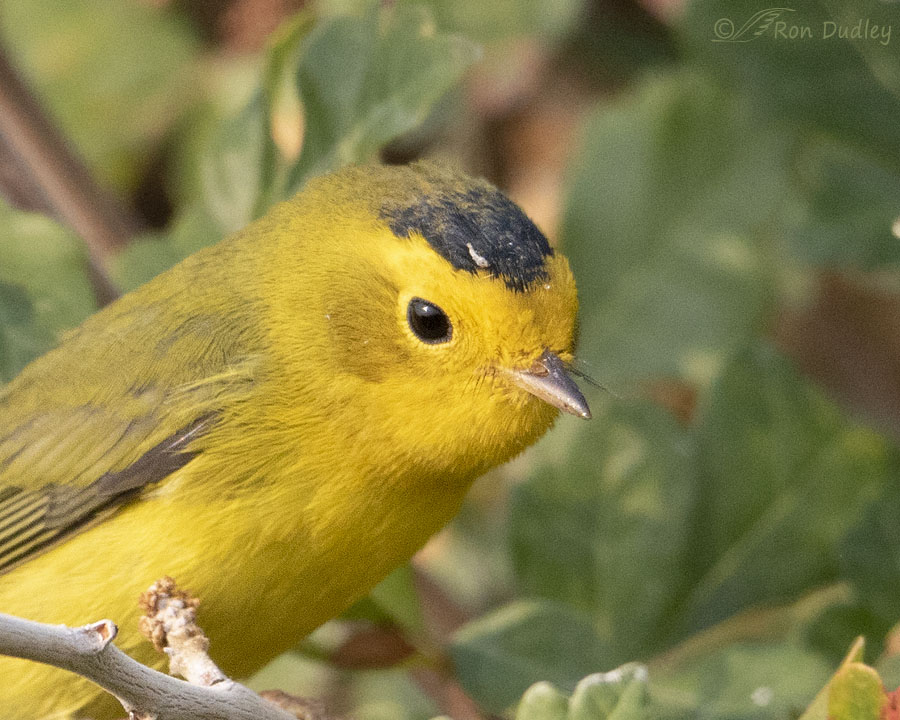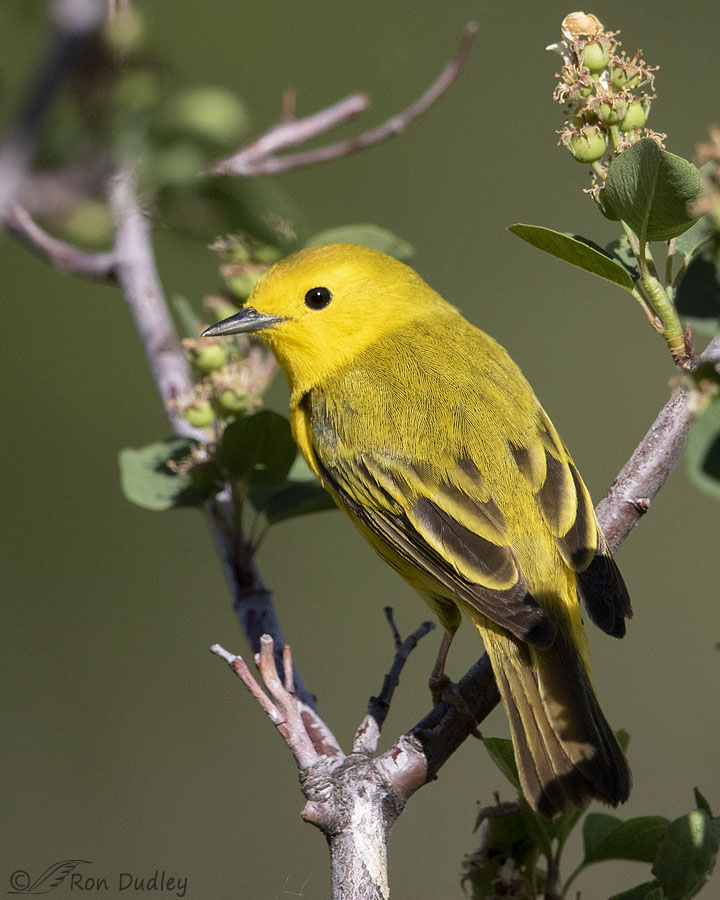Here’s a little warbler detail I’ll bet many birders miss. Until recently I’d certainly missed it.

1/2500, f/5.6, ISO 1000, Canon 7D Mark II, Canon EF 500mm f/4L IS II USM + EF 1.4 III Extender, not baited, set up or called in
I photographed this male Wilson’s Warbler four days ago near a seep in a remote area of Box Elder County. When I first saw this photo I wondered what those black spikey things were that poked forward at the top of his bill.
They seemed to be centered on the midline directly above his bill and I couldn’t see any of them to either side of his bill so at first I ruled out the possibility that they were rictal bristles. Besides, in my ignorance I’d never before noticed rictal bristles on any warbler I’d photographed.
But I wanted a better look at them, whatever they were.

A huge crop of the same photo revealed that they actually are rictal bristles and they aren’t on the midline. Most of them that I’d been seeing in the first version of the photo originated on the left side of his bill. I’d just been deceived by the darker top of his bill into thinking it was part of the mass of bristles (or whatever they were).
And now I could see bristles on the right side of his bill too.

I was surprised. Though I’d never thought about it much I was unaware that any warbler species had conspicuous rictal bristles. Yellow Warblers like this bird are the most common warbler I see and photograph and they certainly don’t appear to have bristles. So I did a little research.
Family Parulidae is composed of several New World genera of wood warblers. One of them is genus Wilsonia, a small genus that includes Hooded Warblers, Canada Warblers and Wilson’s Warblers and it turns out that all three species have conspicuous rictal bristles around the bill. At this point at least it’s my presumption that other genera and other species of warblers do not have rictal bristles, maybe yes and maybe no..
As we’ve discussed in previous posts the actual function of rictal bristles is poorly understood. It has long been speculated that rictal bristles are either sensory (to help them sense or capture prey) or that they might aid in preventing captured insects from scratching the bird’s eyes while they’re being held in the bill. But those potential functions are only educated guesses and there’s apparently no specific evidence to support either one.
Bird authority Dan Gleason included the following about the function of rictal bristles in a comment on an earlier blog post:
- “Experiments, including those on Willow Flycatchers, show no function in food capture… But, they also were not shown to be sensory in function in these birds. Insect capture is with the tip of the bill and the rictal bristles play no role in experimental work done. And no sensory role was also found. Instead, it appears that these bristles helped to protect the eye. Large insects with long legs or insects missed in a strike often came near the eye and were deflected by these bristles. Some people have also suggested that they may also deflect and redirect an insect toward the beak in the case of a near miss.“
But since most warblers are nearly exclusively insect eaters I had to wonder why some of them have rictal bristles and others do not. So I did a little more research, concentrating on two species I’m fairly familiar with – Yellow Warblers and Wilson’s Warblers. Field studies indicate the following about their preferred method of insect capture:
- Yellow Warblers – on breeding grounds in Utah, 2,255 foraging observations categorized as 95.5% gleaning, 1.7% sallying (flying out after airborne prey), 2.8% hovering.
- Wilson’s Warblers – gleaning 75%, sallying 10%, hovering 15%.
So, Wilson’s Warblers ‘sally’ after prey nearly 6 times more often than Yellow Warblers do. It seems to me that catching insect prey in flight during sallies would more likely present a threat from the struggling insect’s legs to the eyes of the bird than simply plucking them off of a branch or leaf (gleaning). Maybe that explains why Wilson’s Warblers have rictal bristles and Yellow Warblers don’t.
Or maybe it doesn’t…
Ron


Very interesting post, Ron!
I never noticed the rictal bristles on some warblers and can’t help but contrast what I learned here with my own puzzlement over their distribution in North American goatsuckers. In fact, it makes goatsuckers even harder to understand. Nighthawks have very short bristles while the others all have very long ones, nearly as long as their skulls. Nighthawks catch nearly all of their food on the wing–Commons at fairly high speed and Lessers at a somewhat slower speed. I know that Poorwills pick up a lot of prey from the ground–maybe a majority of it. I can’t for the life of me put together a theory to explain that difference, except maybe “Legler’s Theory,” Which John Legler at the U of U used to invoke: “Sometimes animals evolve adaptations just for the hell of it.”
Now you’ve got me curious about the goatsuckers, Carel. I wish I had more experience with them. Common NIghthawks are about the only ones I see.
I heard a lot about Legler over the years but I never took one of his classes. By the time I went to the U of U I’d already completed many of my life science courses at USU so I was taking a lot of education courses instead.
But I like his theory!
Curious about. Poorwill feeding on the ground. Is this from personal experience. I admit to having limited experience with them. I have seen Poorwills resting on the ground, but I’ve never observed ground foraging. The article in Birds of the World does not indicate ground foraging. It is a species difficult to observe so I’m interested in learning more about where you have found this information. I would like to learn more if you can direct me. Thanks
Fascinating! I love not knowing, because there’s still the excitement of learning something new!
Such bright, beautiful balls of sunshine! (Although, I’m wondering what Mr. Wilson has all over his toupee!)
I love learning but am frequently shamed and appalled at my ignorance. About so many things.
It does look like an old fashioned toupee doesn’t it, Marty.
I might’ve speculated about this before, and I’m woefully ignorant about evolution, but I wonder if there could be a link between mammal vibrissae and rictal bristles (I almost did it again but managed to get the spelling right this time). Perhaps rictal bristles are an evolutionary remnant.
I had an immature Cooper’s Hawk in the front yard this morning. I’m pretty sure it was the same one you posted yesterday.😉
Lyle, I think you might be interested in this:
https://www.sciencemag.org/news/2016/06/human-hair-bird-feathers-came-reptile-scales#:~:text=Hair%2C%20scales%2C%20and%20feathers%20seem,ago%E2%80%94according%20to%20new%20research.
Isn’t it wonderful that there is always so much to learn – even when it is just that we don’t know. Which gives me at least enticing rabbit holes to wander down.
My brother’s (half) family name is Wilson and they would be proud to have a tenuous link to this beauty.
EC, you make a good point about the value of ‘knowing what we DON’T know.
Oh EC, I love those knowledge rabbit holes. Learning new stuff is just too cool and exciting!
“Or maybe it doesn’t” I think that’s the appropriate phase here. Many good guesses but little hard experimental evidence. When I was first learning about birds these bristles were said to aid like a net for catching insects. Later, I discovered that that idea had never been tested. It seemed obvious. Real experiments have now mostly laid that idea to rest and protecting the eyes is now the best guess. There’s always more to learn and it points out how careful we need to be about our assumptions.
I can’t wait for the weather to change and move out some of this smoke. For the past week the air quality index has hovered between 500 and 600. The meter that shows this level pegs out at 300 – very hazardous. But at least we just have smoke with the fire about 10 miles from us. Several small communities have just been wiped off the map here in Oregon. Nearly 40,000 people still under evacuation or with no home to return to.
Oh Dan. At its worst earlier this year smoke had our air quality pegged at over 800. It was vile. From this side of the world I watch, and I worry. For the wildlife and their habitat and for the people and theirs.
“it points out how careful we need to be about our assumptions”
Exactly, Dan. Assumptions are fraught with a variety of dangers.
Yes, I’ve been reading about those Oregon towns being basically wiped out. So very tragic. I hope your fire doesn’t get any closer!
A yellow bird with a black toupee…Love ‘em 😁 Also love when you teach me something new.
Blue skies before the sun went down last night here in Sacramento ‼️ YAY 🥳
Thanks, Diana. May your blue skies continue!
What Nancy already said !
Thanks, Kris.
This is very interesting and educational. I have never taken photos of Wilson’s or Wood Warblers and no previous knowledge of rictal bristles. Now I want to go back and look at other warbler photos I have to see if it is something I just never noticed?
PS: These are some damn good photos
Everett, I have a Facebook friend who’s been doing exactly that this morning – going back and looking at his old warbler photos to see which ones have rictal bristles.
On a typical morning, I read your blog and comments from a Colorado bird news group while eating breakfast. Both reads this morning caused me to ponder the particular characteristics of birders: endless curiosity, great detail orientation, and wonderful eyesight (or camera-sight or both). Of course excellent hearing is a common asset of birders as well, since most many identify by ear as much as sight.
Your being a skilled birder is certainly part of what makes your blog so interesting.
Thanks very much, Nancy. In my particular case I can guarantee it’s good ‘camera-sight’ rather than excellent eyesight. I used to have very good eyesight but those days are behind me.
“Continuing Education” 😉 It IS interesting as well as the questions that arise regarding possible reason for them……😀 Warblers are such neat little birds.
Little more sun yesterday tho mountains were socked in with “whatever”… Have some fog/mist this morning to add to the “fun”.
Thank you, Judy. So far it’s a little clearer here this morning than it was yesterday.
Very enjoyable discussion about Warblers! Thanks for taking the time and effort to educate about Warblers, one of my favorite Covid companions!
Rick
I appreciate your comment, Rick. I was hesitant about making a post like this because I was afraid it would be too esoteric to appeal to many of my viewers. That may still be the case but at least you found it interesting. Thanks for that feedback.